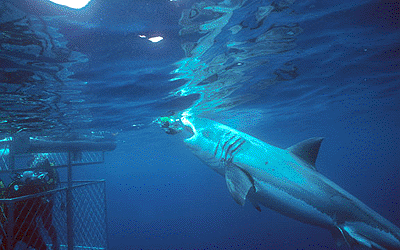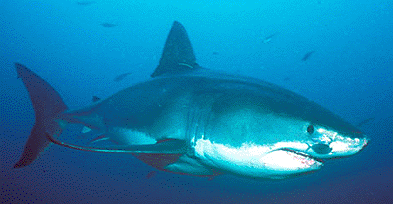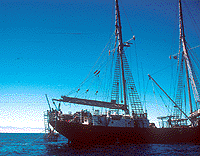|
|
By Carl Roessler

There is a special kind of twilight I experience at only one place in the world. It occurs when my shark cage is lowered down through the surface, slowly descending on down through the dark water to a hovering rest just above the bottom at 60 feet. This is a ghostly world, the sunlight filtered to a level almost spooky in it’s intensity. The water throbs with intensity, because we know that both sharks and their prey are just beyond our view, literally all around us.
|
I have enjoyed this exciting twilight many times, for this is my 28th Great White Shark expedition in South Australia since 1975. For all those years Rodney Fox (the famed white shark victim) and his son Andrew have hosted my adventures, and we have introduced hundreds of avid divers to the ultimate subject in underwater photography.
|
In our pursuit of these massive predators over the years we have used everything from cramped sport-fishing boats to sturdy shrimp trawlers. These days, we have the relative comfort of the huge, 170-foot schooner Falie. This massive two-masted ship has also added a crucial feature for us photographers–the ability to run divers down to the ‘Twilight Zone’ every hour in the unique ‘elevator’ cage.
|
This is a profoundly significant development in the filming of these creatures, for the mood down there in the twilight is very different from what it is up near the surface. This is where the great sharks actually spend their hunting lives, where they stalk unwary prey by looking upward at them. The prey is thus silhouetted against the light surface, while the great white sharks move invisibly across the shadowed depths.
| | |
On this particular week we have at least eight individual great whites circulating below us in the large bay where Falie has anchored. Along the nearby rocky shore, hundreds of sea lion parents are coaching their new pups in the fine art of swimming. For the white sharks, this is hunting heaven. It is winter in these remote, rock-and-scrub-brush islands, cloudy, windy and a bit cold. Waves churn the surface, providing perfect cover for the great dark lords of the deep. You can feel them in the twilight, but you never see them coming until they are upon you. Indeed, this is the essence of the great white shark. The sharks hunt wary sea lions that are brilliantly fast and maneuverable in the water. To catch them, the sharks must be enormously stealthy, ghosts in the shadows.
|
As our cage reaches our hover depth just above the eel grass, I strain my eyes through the dim light, hoping to spot a wide-bodied 14-foot female shark we have named ‘Curly’ for the distinctive upturned tips of her pectoral fins. Curly showed up a few days ago with her belly distended from a recent big meal. She circulated around our cages, but only out of curiosity rather than aggressiveness. She is a beauty, and I am hoping she will show up again for me.
|
| 
| I look toward the surface, where on this cloudy day the vast bulk of Falie is merely a broad shadow so far above us it might as well be on another planet. Even the idea of trying to swim up to the boat when the sharks are prowling is unthinkable. | |
As I watch the distant boat-shadow, I am startled when Curly’s colossal face suddenly appears mere feet from me. Her belly is still a bit distended from her recent feast, but for some reason she is now very curious about us. For the next fifty minutes she gives us a clinic on being an apex predator. She is totally confident in her superior power, sweeping closely past our cage, often brushing her fins against the metal as she passes. I can almost feel her measuring us, wondering what we are and how she could get into our metal structure and have us for dessert.
|
I am framed in my open door on one side of the cage, my exposed form making a convenient target for her. Curly makes several graceful approaches, as if lining up her eventual torpedo run at me. I, of course, take pictures of her as she draws near, and then abruptly realize that if I don’t do something, and fast, her nose will come right through my door! There isn’t time left to close the door, so I reach out and place my hand on her massive nose, nudging it upward where she will bump into metal. It works, and I am delighted later when one of my cage-mates plays a video of the moment when we are back onboard Falie. Some may think that move I made to be foolish, but when you have worked with these animals for decades as I have, you feel you can judge the speed of their moves.
|
Andrew Fox is in the cage with me, moving from side to side with his video camera to get the best angle for each sequence. Both of us have the same thought at the same moment–Curly is cooperating, so let’s go up on top of the cage. We open the top door and climb up where Curly can see us. Up here, there is no shelter but two steel cables, so Curly responds immediately. Slowly she approaches, and you can almost see her thinking through how to avoid the cables. It is a wonderful moment, in that we are out here with her in her dark world. What an adrenaline hit this is! |
| 
|
On another dive Curly doesn’t show up, but a young male named ‘K3’ takes her place. Many of these sharks have shown up before and been tagged by on-board researchers. We have Rachel, a PhD. candidate on board with us. Rachel has an electronic tag riding on a large shark for the next six months, at which time it will send an ‘electronic diary’ of the shark to a satellite for Rachel to collect. Her thesis ought to be exciting reading!
|
Most of what we thought we knew about great white sharks over the past decades has all been changed by the new research and we all are eager for new data. We used to think that these sharks circulated around a few island groups; now we know they swim thousands of miles across open ocean. Satellite tagging is now installed on a half-dozen great whites, and that number will rise quickly. Will we ever really understand them? In a way, I hope not–their continuing mystery is such a big part of their allure… Encounters with sharks like Curly are but daily variations of Rodney and Andrew Fox’s well-organized shark expeditions. Among other attractions the Fox family organizes for divers, fifteen-foot “Johnny” and sixteen-foot “Archie” make spectacular leaps at bunches of dead fish hung out over the side of the ship. Johnny is quite unusual in displaying superior analytical ability. He first lets younger sharks make unsuccessful efforts to take the hanging fish while the crew pulls it away. Sometime during the sequence, Johnny will come up from the deeper water at a sharply rising angle and launch himself at the bait. Johnny wins half the baits he attempts, while the younger sharks are usually frustrated. Like so many other shark observations, our moments with Johnny make us think more deeply about the mental processes of these complex creatures.
| | |
On one dive a young female buzzes us closely from above, while the aforementioned “K3” spends an entire one-hour elevator dive in tight passes around our cage, clearly looking for a way in. I feel like an oversize Chicken McNugget. Other sharks make occasional appearances, taking advantage of our focus on Curly, Johnny and K3 to get altogether too close to us before we see them.
|
Rodney and Andrew Fox’s cruises are organized to be amazingly productive for underwater photographers. Falie, huge and stable, is the best possible platform to deploy both floating cages and an elevator cage simultaneously. I’ll be back there next summer for my 29th adventure, looking for a rematch in the throbbing twilight with Curly. Or Johnny. Or Archie. Or K3. Or… |




